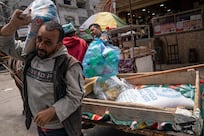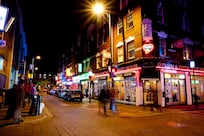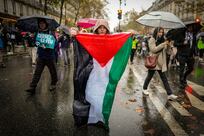The irony of the “Hope Away from Home” theme for this month’s World Refugee Day is palpable given the news of an over-crowded boat capsizing off the Greek coast just a few days ago. This is the latest of many such tragedies in the Mediterranean, the world’s most dangerous migration route.
That sea has taken the lives of over 27,000 people in the past decade, nearly half of over 56,000 migrant deaths worldwide. Other notoriously deadly migration routes traverse the Sahel, originate in West Asia or cross the English Channel.
There are many more hidden casualties among the record-breaking 108 million forcibly displaced worldwide, whose numbers doubled over the past 10 years. They include 35 million refugees, 5 million asylum seekers and 5 million others requiring protection. The remaining 63 million are displaced internally within their own countries.
Decent global citizens are forgiven for not knowing the difference between these categories of desperate humanity. The UN High Commissioner for Refugees (UNHCR) tries to explain, but distinctions without a difference occur because states interpret the 1951 Refugee Convention and 1967 Protocol in nuanced ways.
These instruments define refugees as those “unable or unwilling to return to their country of origin owing to a well-founded fear of being persecuted for reasons of race, religion, nationality, membership of a particular social group or political opinion”. The most crucial component concerns the principle of non-refoulement that derives from customary law dating back centuries. It prohibits returning people to a place where they face torture, cruel, inhuman or degrading treatment and other irreparable harm.
However, only 149 (of 206 countries and territories) have acceded to one or other of the refugee agreements. Others decide on their own scope for refugee protection.
Adding to the confusion are some 260 regional texts concerning refugees, including the 1984 Cartagena Declaration in Latin America and the 1969 OAU Convention on African refugees. Although UNHCR is the official authority to make refugee status determinations, it is nearly impossible for humble refugees stranded somewhere to petition the mighty Geneva-headquartered agency. In practical terms, refugee entitlements are determined by whichever country the asylum seeker can get a hearing from.
When refugee status is finally bestowed, it is a life sentence, with the average refugee spending 20 years in limbo before finding a durable solution. This is either local integration within their hosting nation, re-settlement in a third country or returning to their original home.
Such solutions are rare: In 2022, only 114,300 refugees were re-settled, and 339,300 returned home. Most muddle along where-ever they find themselves, often getting uprooted again and again.
Forced displacement is not equally created. More than half originate from three countries – Syria, Ukraine and Afghanistan. And, of those that flee abroad, 70 per cent are hosted by precarious neighbours. These are generally low- and middle-income countries with their own challenges; the countries hosting the most refugees are Turkey, Iran, Colombia and Pakistan. Among developed nations, the US and Germany have been the most generous in receiving them.
Currently, the world’s largest refugee settlement encompasses 33 highly congested camps in Bangladesh’s Cox’s Bazar. This is the fire-, cyclone- and disease-prone home for nearly a million Rohingya fleeing ethnic and religious persecution in Myanmar.
Also deserving special mention are 5.8 million Palestinian refugees. A 25-year-old Palestinian physiotherapist I met in Lebanon described herself as a refugee even though she was born in Beirut and had lived and worked there all her life. She was a third-generation refugee, inheriting the label along with her DNA and severely restricted civic rights.
The lottery-like global system falls into further disrepute with refugees accused of “asylum shopping” to preferred countries where they may have family or linguistic, cultural or historical post-colonial ties. They are easy prey to unscrupulous human traffickers who destitute the families of potential refugees by demanding exorbitant fees for transporting their loved ones. When someone is “illegally trafficked”, the authorities get further excuse to question their legitimate refugee rights.
Meanwhile, although all communities are instinctively humanitarian – opening their homes and cupboards to strangers in distress – the benevolence is qualified. Thus, the EU offers blanket protection to all Ukrainians, but arrivals from Ethiopia or Sudan who survived horrendously abusive conflicts must prove their worthiness for asylum on an individual basis.
Germany is renowned for opening its borders to a million Syrian refugees. But this is a historical anachronism, as Europeans tighten their borders and squabble internally over burden-sharing. Concurrently, EU policy is externalising border control to reduce refugee entry, for example, with $6 billion to incentivise Turkey to stop refugees getting into the EU. Australia has pioneered the concept of offshoring asylum seekers to Papua New Guinea and Nauru. While the ethics of that are debated, the UK has been inspired to make a similar agreement with Rwanda.
Despite such contradictions, in one sense the refugees are actually the lucky ones: at least they have internationally recognised rights. The internally displaced rely only on the exhortations of the Universal Declaration of Human Rights, which is not legally binding.
That more than half of forcibly displaced people are still contained within their national territories is not a source of congratulation but of concern, because seeking asylum is a last-resort survival route, and closed borders often hide intense cruelty and suffering. Many of the 26 million starving North Koreans would leave to save themselves if only they had the opportunity.
More than one in 74 of our fellow humans have already left home because of violent conflicts, human rights violations and other persecution. This is unsurprising when we live in a deadly era of seemingly endless armed conflicts directly and indirectly affecting two billion people, a quarter of humanity. Those displaced by conflict are being joined annually by more than 20 million escaping climate and environmental disasters. This is projected to increase to a staggering 1.2 billion by 2050, on current trends.
Increasingly, conflict- and disaster-related displacements overlap and potentiate each other, as the case of Somalis or mixed Sahel migrants illustrate. The organisations, conventions and rules from the previous millennium cannot cope with today’s political, economic, environmental, demographic and social complexities. Progressive tinkering of the system has sought improvements but created new contradictions.
An entirely different migration system is long overdue. This should recognise that distinctions between refugees and internally displaced are archaic because the triggers to migration flows do not recognise national boundaries. Neither can necessary solutions be contained within any nation. This calls for globally-shared approaches based on fair and consistent treatment respecting all humanity. It must also enable going beyond an increasingly divisive human rights discourse.
While current geo-politics makes it impossible to achieve consensus on a new system, it is never too early to debate the principles on which this could be based. So that we are ready, whenever we get to the level of global suffering and instability that makes a new migration arrangement inevitable.





